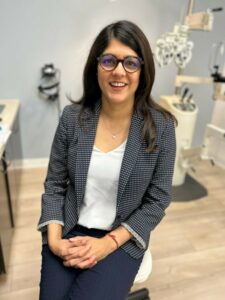March 15, 2024
TORONTO – At THE Myopia Meeting held here, Sunday, December 3, 2023, Radhika Chawla, OD, presented a clinical review on behalf of HOYA Vision Care. The presentation focused on the company’s MiYOSMART spectacle lens for myopia management, including the latest research on the lens, and the ways that HOYA has diversified its lens offerings in recent years.
Prioritizing Education
To kick things off, Dr. Chawla discussed the importance of staying educated on the latest myopia management clinical research, including educating her staff and her patients’ parents.
“We know we’re treating a progressive condition in children from ages 6-18,” Dr. Chawla said. “We know that, clinically, the age of onset is between ages 6-10 for most patients. I practice at a 50% pediatric practice, so I see myopia onset at even earlier ages. As practitioners, we want to make sure that whatever choice we’re making, we’re confident, comfortable, and we can trust the data that we’re using in our decision making.
“What is evidence? It’s not necessarily all the same. When I started using the HOYA lens in my practice, my first question was: why? Why should I be using this? My sales rep explained to me that there are clear, controlled scientifically designed studies that we can trust and feel good about when we’re making our treatment plans for our patients.
“There have been about 25 publications on the HOYA MiYOSMART lenses, and while I’ve read all of them, I’ve also had my staff read them as well. I think it’s important in our practices that everybody is knowledgeable and we’re all able to convey this information to our patients. I’ve also asked parents to read some of them, because everybody likes to be informed, and there’s no better way to be informed.”
Looking at the Evidence
What specific evidence do practitioners need to feel confident in their treatment plans with myopic patients?
Dr. Chawla broke this down for attendees, explaining that HOYA’s studies on the MiYOSMART lenses provide a robust and wide spectrum of evidence, giving practitioners the ability to meet the needs of diverse patients. The studies included children of different ethnicities and age groups, and the studies received acknowledgements and endorsements from credible associations, institutions, and international experts.
“HOYA’s extensive worldwide research provides practitioners with an evidence-based solution, with the answers we can utilize every day in our practices,” Dr. Chawla explained.
Dr. Chawla then described how HOYA tested the efficacy of the MiYOSMART spectacles in both Asia and Europe, and the most recent data is promising. “A new European observational study showed the slowing of myopia progression and axial elongation in Caucasian children compared to published data from untreated myopes,” she said. “Although not directly comparable, the treatment effects in the European cohort in the study were similar to those of the Asian cohort.”
The Longest Myopia Control Spectacle Lens Study to Date
From there, Dr. Chawla highlighted some of the most important findings from HOYA’s ongoing MiYOSMART studies, some of which included:
- MiYOSMART spectacles showed sustained efficacy with no rebound effects.
- There is a 60% slow down of myopia progression for children wearing MiYOSMART lenses.
- The myopia control effect of the lenses was sustained over six years.
- Average myopia progression was less than -1.00D.
- Average axial elongation was less than 0.10 mm per year.
- There is a higher reduction in myopia progression when patients are prescribed a combination of MiYOSMART spectacles and 0.01% low-dose atropine drops.
Dr. Chawla also emphasized that the HOYA MiYOSMART study is the longest-running myopia control spectacle lens study at six years. The study was also published in Scientific Reports in April 2023, which is the fifth most-cited peer-reviewed journal in the world.
Clear and Sun Options
To wrap things up, Dr. Chawla discussed the latest release from HOYA – the MiYOSMART “sun range.”
The photochromic spectacle lenses, MiYOSMART Chameleon, and polarized spectacle lenses, MiYOSMART Sunbird, were developed to slow myopia progression in children using D.I.M.S. Technology while providing protection from intense sunlight. These two new products, along with the MiYOSMART clear spectacle lenses that launched in 2018, give children the freedom to comfortably take part in the activities they enjoy indoors and outdoors without compromising their eyesight.
Due to its HOYA photochromic lens technology, MiYOSMART Chameleon is an all-in-one solution to myopia management and protected outdoor activity. It rapidly adapts to the level of sunlight and fades back to clear indoors in seconds. Meanwhile, MiYOSMART Sunbird is the ideal addition to MiYOSMART clear spectacle lenses, for extra protection from intense sunlight and glare. It also offers vibrant colors and rich contrast in bright light, allowing children to fully experience the beauty of the outdoors.
Dr. Chawla stressed the importance of outdoor time and the effect it can have on myopia progression, and with the MiYOSMART sun range, myopic patients get the best of both worlds. The longer they’re in treatment, the greater their outcomes will be, and these lenses provide children with myopia treatment whether they’re indoors or outdoors.














